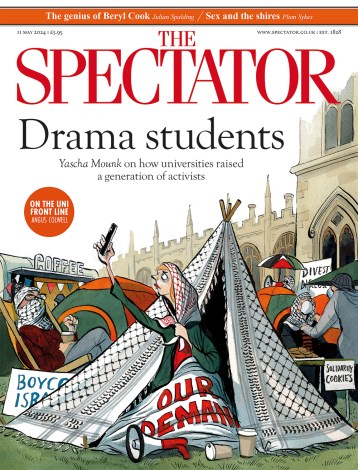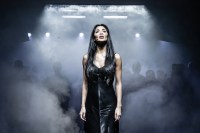Minority Report is a plodding bit of sci-fi based on a Steven Spielberg movie made more than two decades ago. The setting is London, 2050, and every citizen has been implanted with an undetectably tiny neuroscanner which informs the cops about crimes before they’ve been committed. However, as the first scene reveals, the undetectably tiny neuroscanner can be removed from the flesh with a corkscrew. The character who gouges out her tag is a computer geek, Julia, who invented the surveillance method in the first place. She stands accused of planning a murder and she goes on the run to clear her name.
The actors appear to be trapped inside a tangerine lunchbox
Sound familiar? Yes, it’s the trusty old yarn about a truth-telling rebel who quits the force to expose the corruption at its heart. This creaky structure is padded out with car chases, punch-ups, rooftop escapades and the inevitable break-in at police headquarters that reveals the names of the true culprits. Who on earth decided it would be interesting to put this superficial pap on stage?
The lighting effects are fabulous, easily the show’s best asset, but very few members of the audience will appreciate this extraordinary technical achievement. Great action-movie visuals are aimed at younger males who rarely buy theatre tickets – while the true fans of drama don’t want optical wizardry but powerful narratives and compelling characters. And here the show doesn’t deliver.
The story about a detective who investigates their own offence is as old as Oedipus. The relationships between Julia and her various allies and foes are badly focused because there are too many minor roles. She gets into an intriguing love-hate friendship with a digital servant, ‘David’, whose snarky backchat is amusingly provocative but their comic tit-for-tat doesn’t develop. ‘David’ is an androgynous female with a seductive voice who wears a long dark wig and a white jumpsuit, and looks like shadow chancellor Rachel Reeves dressed in one of Angela Rayner’s rejected outfits. It’s a mystery how this hoary old dud got commissioned. Maybe the director, Max Webster, and his adaptor, David Haig, weren’t giving it their full attention.
The Cherry Orchard, in a modernised version by Benedict Andrews, is set in the past but it keeps reminding us of the present as well. The script mentions ‘kulaks’ and ‘roubles’, and the older characters can recall social conditions in Russia before the emancipation of the serfs in 1861. But they also live in a world of scratch cards, vaping and electric pianos.
What strikes the eyeballs, rather too forcefully, is the visual palette. The Donmar stage has been covered with an orange foam carpet that conceals most of the back wall as well so the actors appear to be trapped inside a tangerine lunchbox. All the characters wear baggy nylon clothing, garishly patterned, and they resemble a clan of lottery winners who blew their winnings on drugs and escaped to a caravan park.
One figure, a lovable old eccentric in Chekhov’s play, wears a T-shirt decorated with the face of a cat disguised as Groucho Marx. The ageing footman, Firs, has been re-imagined as a truculent charlady who hobbles about on a walking stick swearing like a crackhead at a detention centre. The entire three-hour show is illuminated by overhead strip lights which make the Russian countryside look like an all-night garage. This is a time-sensitive play that includes references to the arrival of dawn and the shifting atmosphere of an approaching sunset.
There’s no furniture on stage either. Not a stick of it. And furniture is part of the dialogue. The absent-minded Gaev addresses a speech to an antique cabinet, and in this version an audience member is coaxed across the footlights and forced to represent the elderly cupboard on stage. This prank may misfire if the chosen victim refuses to play along.
Some of the actors are all right. Daniel Monks conveys the intelligence and sensitivity of Trofimov, ‘the eternal student’, but he lacks warmth. Lopakhin is played by Adeel Akhtar as a thuggish wide boy, rather unlovable. Nathan Armarkwei Laryea’s Yasha is a smarmy prig who chats up Dunyasha by telling her, ‘a woman in love is either batshit crazy or a slut’. Only Nina Hoss, as Ranevskaya, captures the mood of fractured grandeur and decay.
Like most of Chekhov’s work, this play is very tricky to pull off because the scenes are deliberately vacant and purposeless, and they consist of meandering conversations between overeducated boozers killing time before time kills them. If you get it wrong, you end up with a show that resembles a Channel 4 exploitation documentary about a family of inbred drunkards living on benefits. And here it is. A textbook lesson in the perils of updating Chekhov.
The show ends with a memorable act of vandalism. The trees are felled not with axes but with chainsaws which turns the bitter-sweet conclusion into a whining, choking nightmare. Ghastly.









Comments
Comments will appear under your real name unless you enter a display name in your account area. Further information can be found in our terms of use.